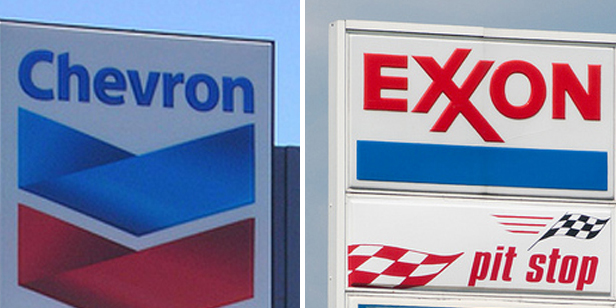CHICAGO (Bloomberg) — Exxon Mobil Corp. and Chevron Corp. easily swept aside analyst estimates as the battered giants of the U.S. oil industry shook off two-and-a-half years of low oil prices and reported surging profits in the first quarter.
Exxon, the world’s biggest oil producer by market value, earned 95 cents a share, outperforming all but one of the 19 analysts’ estimates in a Bloomberg survey. Chevron, the second-largest U.S. driller, swung to a profit in a big way, scoring its largest quarterly gain since 2014 and a per-share result that was 64% higher than the average estimate.
As charter members of the elite supermajor clique that also includes Royal Dutch Shell Plc, BP Plc and Total SA, Exxon and Chevron are among the biggest beneficiaries of the 55% escalation in crude prices from the same period in 2016. Total reported a 56% profit increase on April 26 and if the trend holds, Shell and BP would post impressive results next week.
“It’s cutting costs, it’s getting more for every dollar you spend, it’s getting more from each well and getting it out faster,” said Brian Youngberg, an analyst at Edward Jones & Co. in St. Louis. “It just shows how these companies have had to adapt to a new environment.”
Exxon rose 1% to $82.05 at 10:34 a.m. in New York, while Chevron also was up 1% to $106.53.
Production drop
Exxon’s profit surged even as oil and natural gas production fell 4% from the same period last year, according to a statement from the Irving, Texas-based company Friday. Exxon cut capital and exploration expenditures in the quarter 19% to $4.2 billion.
“In both cases, the earnings beat was largely from realized pricing rather than production,” said Pavel Molchanov, an analyst at Raymond James Financial Inc. in Houston. “Pricing is always a proverbial black box for multinational oil and gas producers, and it is not something that companies can themselves control.”
While benchmark Brent crude rose more than 50% last year to more than $50/bbl, prices are down about 9% in 2017 as a resurgence in U.S. shale production threatens an attempt by the Organization of Petroleum Exporting Countries and its allies to eliminate a global oversupply.
Debut quarter
In his debut quarter, Exxon Chief Executive Officer Darren Woods is focusing on prospects in places as diverse as offshore Guyana and the New Mexico desert to replenish reserves that last year underwent the deepest cut in Exxon’s modern history. Woods’ predecessor Rex Tillerson retired in January to become U.S. secretary of state. Two weeks later, the company announced the $5.6 billion purchase of acreage in New Mexico.
The company’s board expects to make a final investment decision on the 1.4-billion barrel Liza discovery off Guyana’s coast around the middle of this year, said Vice President Jeff Woodbury.
Profit from Exxon’s overseas production climbed $1.51 billion, offsetting a loss from U.S. wells. U.S. crude output climbed 2.6% during the quarter as oil production dropped in every other region of the world. Exxon’s cash balance was up 32% during the quarter to $4.9 billion.
First-quarter net income rose to $4.01 billion, or 95 cents a share, from $1.81 billion, or 43 cents, a year earlier, according to the statement. Exxon had been expected to post per-share profit of 86 cents, based on the average of 20 analysts’ estimates compiled by Bloomberg.
Chevron slims down
Chevron curbed operating expenses by 14% and drove drilling outlays down 30% during the January-to-March period, the San Ramon, California-based company said in a statement on Friday. The company reiterated plans to lift full-year output by 4% to 9%, excluding the impact of asset sales.
For Chevron, 2016 was a painful year. The company posted its first annual loss in at least 36 years and failed to replace all the crude and natural gas it pumped with new discoveries. As a result, Chief Executive Officer John Watson vowed to cut spending by 15% this year to cope with the lingering cash flow impacts of the worst oil market crash in a generation.
Watson has also said he’s devoting 75% of the 2017 drilling budget to U.S. shale fields and other projects that will generate cash within two years. That’s a titanic shift for an operator renowned for its proficiency in constructing massive, intricate crude and gas projects that produce for decades.
On Friday, the company swung to a profit of $2.68 billion, or $1.41 a share, in the first quarter, compared with a loss of $725 million, or 39 cents, a year earlier, according to the statement. The company had been expected to disclose per-share profit of 86 cents, based on the average of 22 analysts’ estimates compiled by Bloomberg.
The profit result included a $600 million boon from an asset sale, which accounted for about 32 cents of the per-share gain, according to Bloomberg calculations.
Downstream help
Throughout the downturn, the major oil companies have had refining and chemical profits to offset some of the losses. Now those so-called downstream profits are reinforcing the recovery. Chevron saw earnings in the segment rise 26% in the quarter compared to a year earlier, contributing $926 million. Exxon saw 56% higher profits in its U.S. refining business.
Worries are not over for the industry. The rise in oil prices stalled and has lost ground as concern builds that the surge in U.S. production will undermine efforts by OPEC to reduce global oversupplies. The U.S. oil benchmark fell to a one-month low Thursday as the market waits to find out whether production cuts led by OPEC will be extended another six months to bolster prices.
“The sweet-spot of financial firepower -– and therefore higher returns to shareholders –- still requires significant price recovery,” Alastair Syme, an analyst at Citigroup Inc., said in an April 19 note.



